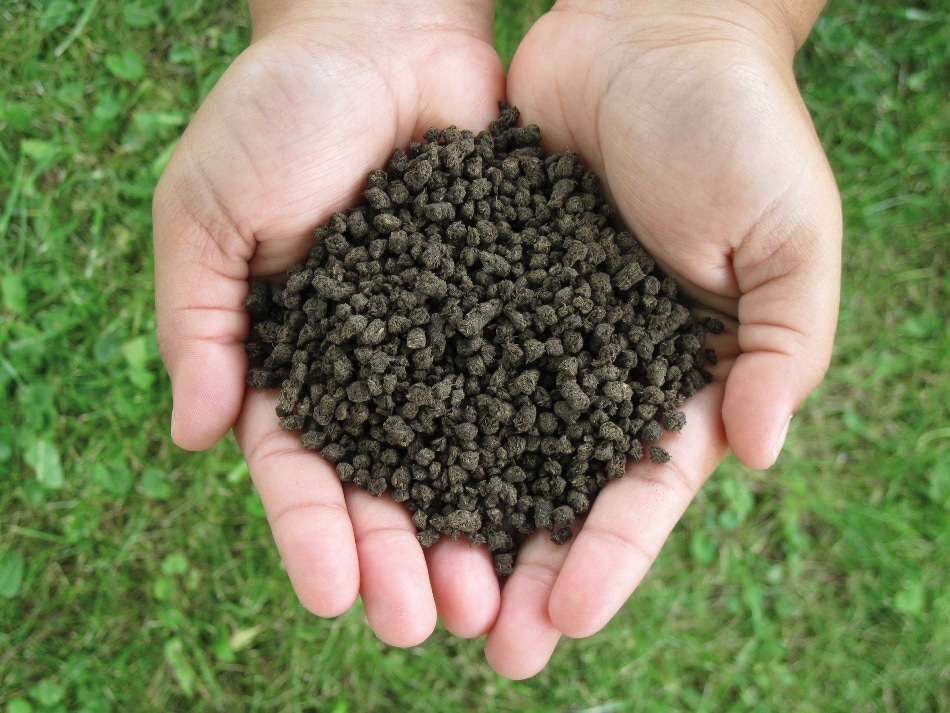May 4 2018
SUEZ Germany, an operator of large-scale plants, will be introducing to the market the BioEcoSIM process for the treatment of liquid manure devised by researchers at the Fraunhofer Institute for Interfacial Engineering and Biotechnology IGB. This offers farms a chance to dispose of surplus digestate and manure.
The end products of slurry treatment are organic soil improvers, ammonium fertilizers, and phosphate fertilizers. The partners will announce their collaboration for the market launch at IFAT from May 14 to 18, 2018, in Munich.
 The BioEcoSIM process supplies both mineral ammonium and phosphorus fertilizers, and humus-forming soil improvers. (Image credit: Fraunhofer IGB)
The BioEcoSIM process supplies both mineral ammonium and phosphorus fertilizers, and humus-forming soil improvers. (Image credit: Fraunhofer IGB)
Each year in Germany, nearly 200 million cubic meters of liquid manure from livestock farms reach the meadows and fields. Over 90% of the “black gold” is made of water and includes significant amounts of the vital plant nutrients phosphorus and nitrogen. Yet, the application of more liquid manure to the fields than the amount that can be bound by the soil and absorbed by plants could result in microorganisms converting the ammonium nitrogen in the soil into nitrate that slowly reaches the groundwater.
The challenge is that in places where huge quantities of liquid manure are generated, there is usually a dearth of arable land that has to be fertilized. As a result, so-called slurry exchanges are used by fattening farms to order tankers to transfer their slurry to areas that need nutrients - usually several hundred kilometers apart.
The BioEcoSIM process developed by the Fraunhofer Institute for Interfacial Engineering and Biotechnology IGB is an environment-friendly solution. “We have combined various processing steps into an overall process and integrated them in a modular plant,” explained Dr Iosif Mariakakis, the Fraunhofer IGB nutrient expert. This enables the priceless nutrients to be retrieved as exactly metered and easily transportable ammonium and phosphorus fertilizer salts.
An energy-efficient process is adopted for recycling the solid organic components by drying and conditioning. Then, they can be availed in the form of humus-forming soil improvers. Thus, farm slurry is nearly recycled entirely, and the recycled components get back to the soil.
Large-Scale Implementation and Operator Model
At present, Fraunhofer IGB has collaborated with SUEZ Germany to gain a license for the patented technology. The waste recovery and recycling company, which operates worldwide, will invest in processing plants as an operator.
Gradually, large-scale technical facilities are to be built, on a nationwide basis, to take surplus manure from farmers, breeding and fattening farms. Especially the logistical aspects of delivery will be taken into account when selecting the plant locations.
Kai Bastuck, Head of Recycling & Recovery Business Unit Development - SUEZ Germany
By recovering the finite raw material phosphorus, Germany’s dependence on phosphorus imports is reduced. This conserves finite phosphorus resources and reduces pollutant inputs into soils. In this way, we contribute to a sustainable future and turn nutrients into valuable substances.
Kai Bastuck, Head of Recycling & Recovery Business Unit Development - SUEZ Germany
At present, a first processing plant with a turnout of 1 m3 per hour is under construction as a “Living Pilot Plant” at SUEZ’s Zorbau site in Saxony-Anhalt. The plant, which is flexibly designed, will process pig and cattle manure, and also fermentation residues from biogas plants, thereby serving as a blueprint for more large-scale plants.
An average industrial-scale plant then produces about 100 kilograms of phosphate fertilizer, 100 kilograms of nitrogen fertilizer and 900 kilograms of organic, nutrient-poor solids per hour from ten cubic meters of raw slurry.
Siegfried Egner, Head of Department at Fraunhofer IGB
A plant with a capacity to process one million cubic meters of liquid manure every year, corresponding approximately to the amount from about 100 pig fattening farms, can synthesize 10,000 metric tons of phosphate fertilizer and 10,000 metric tons of ammonium fertilizer. These values correspond to nearly the annual requirements for entire Germany.
The BioEcoSIM Process
A number of process steps are needed to entirely process liquid manure. The first step involves pretreating the aqueous liquid manure for completely dissolving the phosphorus. Through a two-stage filtration, it is separated into a liquid and a solid phase.
An energy-efficient process, also devised at Fraunhofer IGB, is used for drying the dewatered solid phase, which is carried out with superheated steam in a closed system and is hence specifically energy-efficient. The dried organic components can alternatively be further transformed into organic biochar at 450 °C through a pyrolysis step—similar to the drying step in a superheated water vapor atmosphere.
The dissolved inorganic nutrients are contained in the liquid manure fraction. Phosphorus is initially recovered in a precipitation reactor, and then precipitated and filtered off as magnesium ammonium phosphate, magnesium phosphate, or calcium phosphate. Then, nitrogen is recovered. To achieve this, the aqueous fraction is disintegrated as ammonium sulfate through the membrane distillation process and then crystallized. The remnant is just water containing only traces of nitrogen and phosphorus but rich in potassium; this can be best applied for irrigation purposes.
With large-scale field studies and investigations, the Fraunhofer scientists have demonstrated that the organic soil improvers and mineral fertilizers synthesized from farm slurry can be directly used as readily available humus-forming substrates and fertilizers for agriculture.
The BioEcoSIM processing technology was developed as part of the BioEcoSIM project, funded by the 7th EU Research Framework Program from October 2012 to December 2016.
Presentation at IFAT
The collaborators will be available at IFAT 2018 in Munich from May 14 to 18, 2018, for discussions and for offering further information: Fraunhofer IGB at the Fraunhofer joint stand in Hall B2, Booth 215/314; SUEZ Germany in Hall A6, Booth 239.